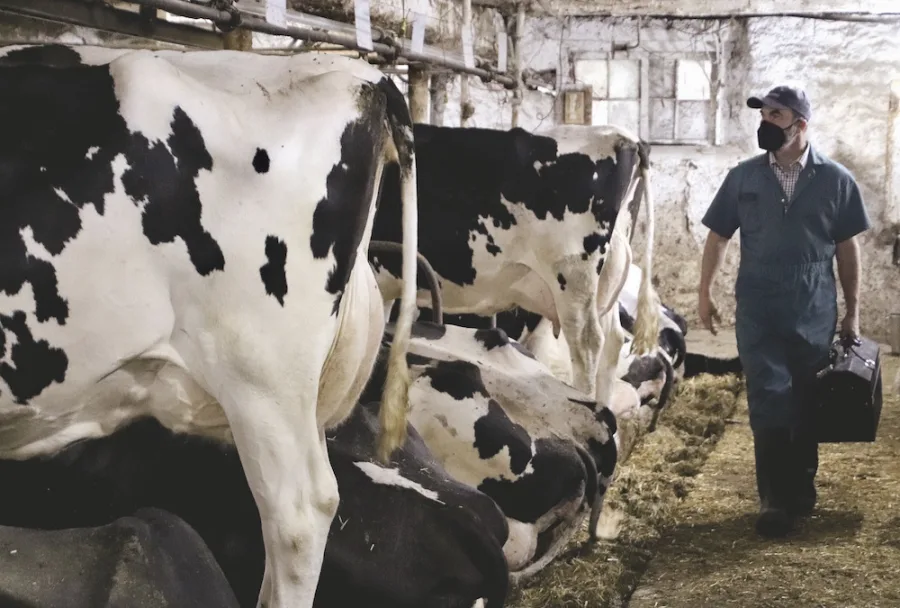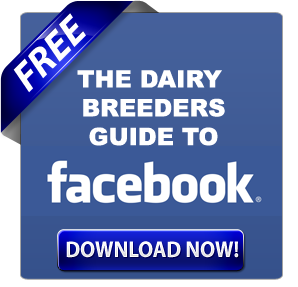Find out if semi-skimmed milk could help ease depression and anxiety. Could this everyday dairy product be vital in farmers’ mental health plans?
Picture starting your day with a glass of semi-skimmed milk, not just for its surprising psychological effects but also for its nutrients. Regular consumption of this type of milk, as per new studies, may reduce the risks of depression and anxiety, thus highlighting a significant link to mental well-being. This presents an empowering opportunity for dairy farmers to underscore the benefits of milk beyond physical health. With depression affecting roughly 3.8% of the global population and anxiety affecting 4%, the need for actionable solutions is crucial. This presents a chance for dairy farmers to play a pivotal role in reimagining how milk can be integrated into mental health plans, not just for consumers but also in terms of marketing dairy.
A Silent Battle: Unraveling the Shadows of Depression and Anxiety
Two of the most often occurring mental diseases today, depression and anxiety, affect millions of people worldwide. These disorders strain mental and emotional aspects of life and force medical systems to their capacity. Depression affects approximately 264 million people worldwide, according to the World Health Organisation; anxiety disorders affect a similar number; hence, they are a major worldwide problem.
Mental health problems have enormous personal costs. Many people suffer, lose interest in everyday activities, and worry a lot. Physical health can also deteriorate since anxiety and depression connect to chronic conditions like diabetes and heart disease. These diseases influence society beyond only personal suffering. They cause lost output, more disability claims, and increased healthcare expenses. Their broad influence indicates that they are among the leading causes of world disability.
Presently used treatments mainly consist of medicine and therapy. For some, they work; for many, they are insufficient. Many times, with side effects and slow action, antidepressants and anti-anxiety medications leave a gap for those in need of immediate assistance. Furthermore, access to mental health care differs significantly depending on area and income level, which makes it challenging for everyone to get the required treatment. This unequal access accentuates the hunt for workable answers.
This reality is apparent: less than half of the worldwide burden of these diseases is covered by conventional therapies. This emphasizes the need for fresh ideas. Studies on food and mental health reveal that diet could assist in the battle against mental health problems. Changing your diet and including some milk kinds seems interesting. They provide hope by stressing the need for creative approaches to mental health treatment and investigating the relationship between food and mood. It is abundantly evident as we examine these connections that our diet may assist in the combat of anxiety and depression.
Mood Swing: Milk’s Role in Mental Health Through History and Science
People have long been fascinated by the relationship between milk intake and mental health. Dairy was a diet mainstay long ago because it provided vital nutrients. Though its mental health advantages were hypothetical then, the Greeks and Romans prized milk for its strength-giving qualities. Our understanding changed with science. Dairy’s calcium and vitamin D content came to be seen as vital for physical and psychological well-being.
Turning to the late 20th century, scientists began examining how diet influences mental health and the brain. Studies revealed that the kinds of fat and vitamins in milk could affect anxiety and mood. Still, there were arguments about this. Some mid-1900s research questioned the advantages of high saturated fat, usually found in whole cream milk, linking it more to physical health problems. This produced recommendations for semi-skimmed or skimmed milk.
Research into the effects of semi-skimmed milk on mental health is not a recent development; it has a long legacy. Modern techniques are now helping researchers better understand these connections. This history of research is a testament to our progress in understanding the relationship between diet and mental health. It also serves as a call to action, urging us to continue our exploration and make informed decisions about our health and well-being.
Pouring Over Data: Milk’s Subtle Impact on Mental Health Examined
Particularly about depression and anxiety, the study looked at whether milk intake affects mental health. Examining 357,548 people without these problems first using the vast UK Biobank data, The aim was to find how various milk kinds affect mental health. Considering age, gender, lifestyle, and health, the study found relationships between milk intake and new cases of depression and anxiety using Cox proportional hazards models. Mendelian randomization (MR) analysis was conducted to support these results and search for causality. This approach avoids typical prejudices by using genetic variations affecting milk consumption to grasp better if these links can influence mental health. Emphasizing diet’s crucial part in mental health, the study generally suggests that semi-skimmed milk could help prevent depression and anxiety.
Cow’s Counsel: Semi-Skimmed Milk as a Shield Against Depression and Anxiety
According to the study, drinking semi-skimmed milk has a significant relationship with reduced depression and anxiety risks. Comparatively to those who did not drink semi-skimmed dairy, those who consumed it had a 12% lower risk of depression and a 10% lower risk of anxiety. Mendelian randomization analysis supports this by showing protective effects on mental health problems, including anxiety and depression. On the other hand, although it did not affect depression, full-cream milk was linked to less anxiety. Skimmed milk and other milk varieties did not show protective effects for these mental health issues, meanwhile. The study notes semi-skimmed milk as a possible mental health booster.
The Nutritional Symphony: Exploring Milk’s Role in Mental Wellness
A brand-new field of research examining how our diet influences our mental health is nutritional psychiatry. Our brain function and our diet can affect mood. Reduced cases of problems like depression and anxiety are associated with a diet that includes the correct nutrients. This indicates that adjusting our diet might help control mental health issues. Rich in minerals, vitamins, and proteins, milk is Not only is it good for our bones; it may also improve our mental health. Tryptophan in milk helps synthesize serotonin, our “happiness hormone.” Mood depends on serotonin; thus, drinking milk could reduce anxiety and depression risk. Other milk nutrients, including potassium and vitamin B12, help brain function. While potassium supports nerve action, vitamin B12 helps generate brain chemicals that influence mood. Given these advantages, milk could be a good component of a diet meant to support mental health.
Farmers at the Forefront: Navigating the Intersection of Dairy and Mental Health
Dairy producers are not just farmers but are at the forefront of a crucial intersection between farming and health. Their choice of output gives them a unique opportunity to influence public well-being. By focusing on semi-skimmed milk, they can become major players in nutritional psychiatry, the study of how diet influences mental health problems, including anxiety and depression. Their role is to produce milk and promote mental health and well-being.
Strategies for Production and Marketing
Clever manufacturing and marketing strategies can help promote semi-skimmed milk. Farmers should emphasize sustainable and ethical farming to maximize milk’s natural advantages and align with consumer values. They can attract health-conscious consumers who seek quality by choosing organic methods and green technologies.
- Brand Building: Storytelling about farm-to-table methods and milk’s mental health advantages will help build consumer interest and confidence.
- Collaborative Efforts: Working with retailers and health professionals to emphasize semi-skimmed milk as part of a healthy diet can highlight its psychological advantages.
Benefits for the Dairy Industry and Consumers
Emphasizing semi-skimmed milk will help dairy companies appeal to health-conscious markets and establish their leadership in nutrition and wellness. This focus on supporting mental health can increase customer loyalty and boost demand, aligning with the trend towards functional foods.
Consumers will benefit from informed decisions and improved mental health. They can select a dairy product that might help control their mood, reducing the demand for medication.
How the Nutrients Work
The nutrients in semi-skimmed milk—especially calcium and tryptophan, which are essential for producing neurotransmitters—probably help explain its advantages for mental health. Calcium is a key mood regulator, and tryptophan, a precursor of serotonin, suggests that milk may improve mood and stability via these mechanisms.
These nutrients highlight semi-skimmed milk’s importance in physical and mental wellness. They support brain function and might help with symptoms of mood disorders.
Nutrient-Packed Remedy: How Semi-Skimmed Milk’s Composition Supports Mental Health
Semi-skimmed milk addresses not only essential nutrition but also mental health, more especially depression and anxiety. This could be related to its nutrients and how they influence brain systems, such as serotonin, which is crucial for controlling mood.
Nutritional Perks:
- Proteins: Contains casein that might lower stress hormones and anxiety.
- Calcium: Helps in making serotonin, which can boost mood.
- Fats: Has both healthy and moderate saturated fats that support brain health.
Boosting Brain Chemicals:
- Serotonin Support: Helps increase serotonin, a chemical linked to happiness.
- Dopamine Help: Provides fats that help make dopamine, the key to feeling good.
Combining nutrients in semi-skimmed milk could benefit the brain, support mood, and improve mental health. However, more research is needed to understand these impacts better.
Cows and Conscious Choices: The Semi-Skimmed Milk Revolution on the Horizon
This study will be of great relevance to dairy farmers. The research links semi-skimmed milk to mental health advantages, influencing consumer decisions. Imagine the marketing increase: advertising semi-skimmed milk for mental health and nutrition. This might affect manufacturing techniques and raise demand.
Semi-skimmed milk could be a top choice for calorie-conscious consumers and everyone searching for better options. Since consumers are more aware of diet and health, commercials stressing these psychological advantages could be a good way to target this new market. Educational campaigns, partnerships with mental health organizations, or professional endorsements could support these initiatives.
From a production standpoint, dairy producers might change their methods to satisfy this increasing demand. Reviewing breeding programs to increase yields or streamlining feed to guarantee quality and quantity could help. New product development has promise, such as new semi-skimmed milk products emphasizing these results.
This study might open a new chapter for dairy production and put farmers at the junction of mental health and nutrition. Accepting these results has financial advantages and fits current lifestyle trends, enhancing consumer confidence and loyalty.
Sipping Your Way to Serenity: Daily Nutrition Strategies with Semi-Skimmed Milk
As we explore the benefits of semi-skimmed milk for mental health, here’s how you can easily add it to your diet:
- Try It Out: If you are not yet inclined to use semi-skimmed milk, please initially put it in your tea or coffee. This is a fundamental approach to acculturating to the taste.
- Smoothie Addition: Substitute semi-skimmed milk for water or sugary juices in your smoothies. It provides protein, calcium, and creaminess.
- Baking Swap: Baking calls for semi-skimmed milk rather than full cream, which reduces saturated fat while maintaining taste.
- Pair with Fiber: Enjoy semi-skimmed milk alongside fruit and whole grains. This can help you maintain your emotional balance.
- Choose What Works: If you prefer plant-based choices or are lactose intolerant, look at lactose-free or fortified substitutes.
- Moderation is Key: Semi-skimmed milk should be part of a balanced diet with various nutrients.
Though diet changes are only one aspect of the picture, they can improve mental health. See a medical practitioner to identify the ideal foods for you.
The Bottom Line
Semi-skimmed milk is an excellent help for mental health in a world of difficulties. It shows how our daily decisions shape our minds and is part of a comprehensive approach to feeling good. This concept emphasizes the close correlation between our mood and our diet. It motivates more investigation of these relationships. Farmers, dietitians, and researchers are poised for significant revelations that might alter our perspective on mental health. With increasing data, everyone has an exciting opportunity to see the advantages of semi-skimmed milk. Including it in daily meals helps us to realize how much our food decisions affect our mood.
Dairy producers depend significantly on this period. Maintaining these results stimulates sector innovation and demonstrates how dairy can enhance public health. Using these realizations offers an opportunity to start conversations about how diet supports mental fortitude. Let’s investigate how semi-skimmed milk might help us create a better future. Your next sip might bring more strength and peace.
Key Takeaways:
- The study suggests a protective link between semi-skimmed milk consumption and lower risks of depression and anxiety.
- Semi-skimmed milk’s unique nutrient composition may play a role in supporting mental wellness.
- Data comes from a significant pool of over 357,000 UK Biobank participants, offering robust insights.
- Mendelian randomization further supports potential causal relationships between semi-skimmed milk and mental health improvements.
- Full cream milk similarly showed benefits regarding anxiety but not depression.
- No significant connections were found between skimmed milk and mental health conditions.
- Further research is critical to understand fully how milk influences mental health and confirm these findings.
- Dairy farmers can play a crucial role in mental health dietary strategies by promoting semi-skimmed milk.
- Limitations include self-reported data and a focus on an older demographic of European descent, indicating the need for broader studies.
Summary:
Did you know that semi-skimmed milk might do more than help your bones? A significant study with over 350,000 people found that this type of milk could help protect you from depression and anxiety. Every glass you drink might boost your mental health, which is an excellent win for dairy farmers! People are getting more thoughtful about what they eat, and choosing semi-skimmed milk could be a step towards feeling physically and mentally better. New research shows that regularly drinking semi-skimmed milk might lower the risks of depression and anxiety. These mental disorders affect a large portion of the population, and they’re tied to physical health issues, too. Traditional treatments include therapy and medication, but they aren’t always easy to get. That’s why exploring how food affects mental health is essential. Dairy companies have a chance to make a difference, and farmers should focus on sustainable practices to offer milk that aligns with people’s values.
Learn more:
- Why 80% of U.S. Dairy Farms Are Struggling: An Insider’s Look at the Unseen Challenges
- Essential Tools to Save Lives: Mental Health Resources for Dairy Farmers
- The Death of Small US Dairy Farms: An Autopsy Report
 Join the Revolution!
Join the Revolution!
Bullvine Daily is your essential e-zine for staying ahead in the dairy industry. With over 30,000 subscribers, we bring you the week’s top news, helping you manage tasks efficiently. Stay informed about milk production, tech adoption, and more, so you can concentrate on your dairy operations.







 Join the Revolution!
Join the Revolution!





